Apple's 15-inch Core i5 MacBook Pro: The One to Get?
by Anand Lal Shimpi on April 14, 2010 10:38 PM EST- Posted in
- Mac
- MacBook Pro
- Arrandale
- Core i5
- Laptops
They’re Actually Faster
Benchmarking under OS X isn’t difficult, you just need to get creative. Luckily I’m in dire need of creative outlets so creating OS X benchmarks works for me. I’m using the same tests I introduced in my Holiday 2009 Macbook Pro roundup and running on the same hardware (specs listed in the tables on the previous pages). The Core i5 system is the new entry level 15-inch MacBook Pro.
We’ll start with general application performance.
General OS usage is a difficult thing to quantify, but one measure of performance has always been the number of bounces an icon in the dock makes before an application loads. I decided to take it to the next level and write a quick script to launch 15 applications in a row, timing how long the entire process takes.
I launched, in order: Mail, Safari, Activity Monitor, iTunes, iCal, DVD Player, iPhoto, Photo Booth, Quicktime Player, Disk Utility, Preview, iMovie, Front Row, Garage Band and Aperture.
The entire process stresses both the disk and CPU, which is why we see a huge improvement when going to an SSD as well as differences between CPU speeds.
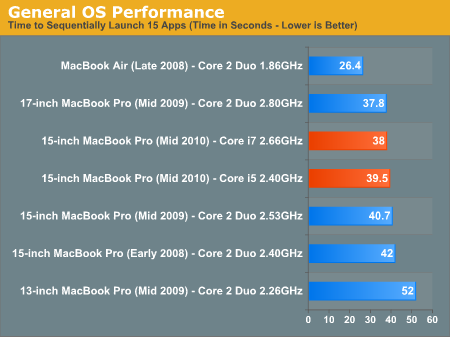
My application launch test absolutely rocks on the MacBook Air because it ships with an SSD by default. The MacBook Pros are stuck with mechanical hard drives and thus don’t perform nearly as well. If you’re curious, installing an Intel X25-M G2 in any of the MBPs will drop their times to 16 seconds or less.
The new MacBook Pro also doesn’t improve performance that much. I measured a 3% increase in performance, which although repeatable, isn’t really spectacular. This is compared to the old 2.53GHz Core 2 Duo and should serve as a baseline for the minimum performance improvement you should see. In other words, the 2.4GHz 15-inch MacBook Pro should perform no worse than last year’s 2.53GHz model.
The $2199 model with a Core i7 running at 2.66GHz pushes performance up another 3.9% over the base model. That's actually more than I expected but the real strength of the i7 is visible in the more CPU bound tests.
Adobe Photoshop CS4 Performance
The Retouch Artists Speed Test we use for our CPU testing under Windows also works under OS X. We're running the exact same benchmark here, basically performing a bunch of image manipulations and filters and timing the entire process.
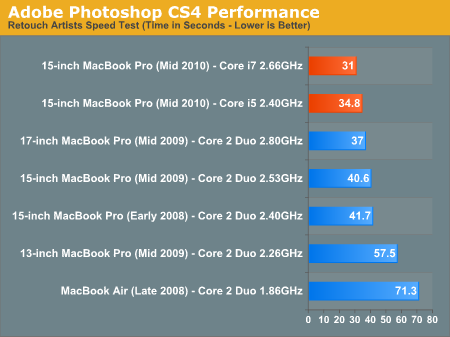
The old 13-inch MacBook Pro is penalized by only shipping with 2GB of memory, which is why it performs so poorly here. The real comparison is between the 2.4GHz Core i5 vs. the 2.53GHz Core 2 Duo from last year. The former is 16.6% faster in our Photoshop test. In fact, the new 15-inch MacBook Pro is even faster than the older 2.80GHz 17-inch model I reviewed.
The Core i7 model is 12.3% faster than the baseline Core i5 2.40GHz. Definitely noticeable.
Aperture 2 RAW Import
For my Aperture test I simply timed how long it took to import 203 12MP RAW images into the library.
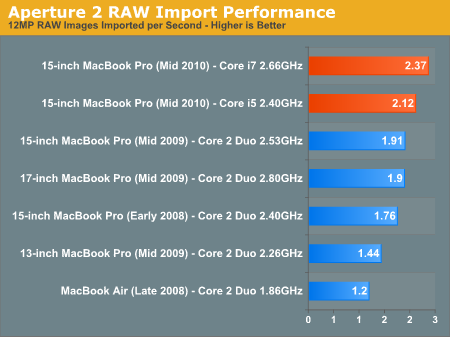
The new entry level 15-inch MBP is 10.9% faster than the old MacBook Pro, and again, it’s faster than the old 17-inch model as well. Moving to the Core i7 gives you another 11.8%.
Cinebench R10
I’m a fan of the Cinebench test because it lets me show off both single and multithreaded performance in the same workload. First, the single threaded performance:
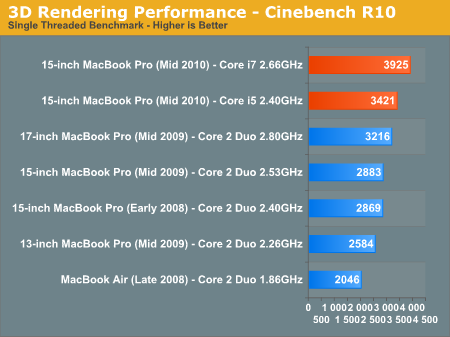
Here we have a huge advantage on the new MacBook Pro. Intel’s Turbo Boost is active here, resulting in a large performance advantage, not to mention all of the enhancements present in the Nehalem/Arrandale architectures. This is one of the best situations for the Core i7 vs. the i5. The extra $400 gives you another 14.7%, not bad at all.
Multithreaded performance is equally impressive:
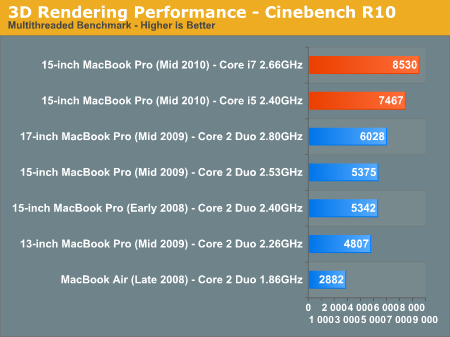
Thanks to Hyper Threading, the new Core i5 puts a generational gap between itself and last year’s MacBook Pro in this test. Whether you’re running single threaded or multithreaded applications, the Core i5 can be noticeably faster than the Core 2 Duo.
Quicktime H.264 Video Encoding
Our final benchmark is more consumer focused. Here I'm taking an XviD and converting it to an iPhone-supported H.264 format.
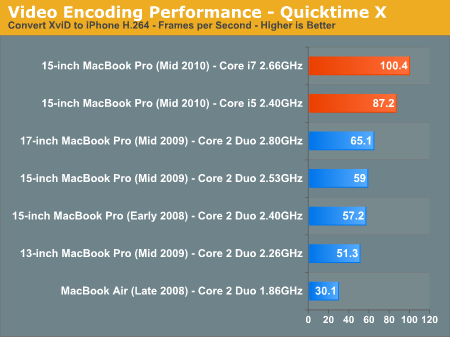
Video encoding is one of the i5’s definite strengths. If you do a lot of video encoding on your notebook, the jump from Core 2 to i5 is tremendous - approaching 50% in this case even despite the “lower” default clock speed. This is also the best showing for the Core i7 - count on an extra 15% over the base Core i5.
Core i7 vs. Core i5 Performance Summary
The two Core i5 models Apple offers ship with a 2.40GHz or 2.53GHz processor, both with a 3MB L3 cache. The $2199 15-inch MacBook Pro comes with a 2.66GHz Core i7, with a full 4MB L3 cache. Compared to the entry level model that's an 11% increase in clock speed and a 33% increase in L3 cache.
While I don't believe there's much reason to go for the 2.53GHz over the 2.40GHz model (L3 cache size remains the same, clock speed goes up by a small amount), the Core i7 is actually pretty decent. For a 22% increase in total system cost you end up with 11 - 15% better performance in CPU bound applications. It actually even feels snappier in general use as well.
I'd still suggest opting for an SSD before considering any CPU upgrades, but if you're looking to keep your new MacBook Pro for a while the Core i7 is worth it.










114 Comments
View All Comments
oldbriones - Thursday, April 15, 2010 - link
I am disappointed, once again, that apple slapped on crappy TN panels to their MacBook Pro.Use of IPS panels in iPad, new iMacs, and new Cinema Displays were welcome changes for the better
(far superior viewing angle, color integrity). Why not in the Pro line of MacBook ?!
beginner99 - Thursday, April 15, 2010 - link
to increase margins. fanboys will buy it anyway (no sane person would for this price...)It's like 800$ extra compared to similar dell, hp,... models.
that_guy_mike - Thursday, April 15, 2010 - link
by that logic no one would drive a mercedes or bmw either since you can get a honda for way less, and they're clearly the same since they are all just cars.The0ne - Thursday, April 15, 2010 - link
That's retarded. When referring to laptop the margins/difference in hardware and much less than comparing vehicles. It's the same hard drive, same memory, etc. A car may be a car but the process of getting there is absolutely different, less being the same part.Now if you were to say, why not buy a car with almost the same parts and materials, slap on a Mercedes logo, and charge a premium for it then that would make more sense.
mikesmithson - Friday, April 16, 2010 - link
You mean how like the difference between a Honda Accord and an Accura TL? Like how they use a lot of the same parts... Accord starts at $21,000; TL at $35,000...maler23 - Thursday, April 15, 2010 - link
Prolly the odd man out, but I'm waiting for a review of the 13 inch model. I was already pretty much decided on the MBP 13in anyways, so any upgrades for the same price is a perk.The lack of Arrandale kinda hurts though; I'm also wondering if the nVidia 320M makes things run any hotter. I'd love to hear a good reason why Apple skipped the Core i3 and stuck with the Core Duo. I'm assuming it was a space concern due to the whole Intel/NVidia chip kerfuffle and they wanted to keep the same sized chassis?
Anand, any bets on an Arrandale update for the Fall for the MBP 13?
cheers!
-J
solofest - Thursday, April 15, 2010 - link
I second the request for a 13" review. I'd like to see how the 320M stacks up, as well as some real world battery tests. Re: an Arrandale update for the 13" in the fall, sounds like Apple may as well wait until Sandy Bridge?solipsism - Thursday, April 15, 2010 - link
Ditto.The tests of Core-i3 and having to use Intel HD over a speed bump in C2D and Nvidia 320M tell me that Apple made the right choice. I can't see the 13" MBP maintaining the same price point or increasing the battery duration with a discrete GPU.
I think Anand is correct in that the a Fall release is inevitable. While this is is a decent update I think it is meant to be a stopgap for more radical changes. What should have come about 7-8 months later may jut 4-6 months later due to the Arrandale supply issue.
For the next release, the 13" MBP may have to drop the ODD to make room for the component and cooling, and to lessen the blow of the GPU cost. Apple obviously isn't going to offer Blu-ray so I'd say they are just holding onto the internal ODD until offering Mac OS X Restore Discs on a 16GB SD Card is more viable. I don't think they added SD to the 13" and 15" so many years after it was standard, just to say "me too". I think it'll be the new way to restore the disc. It's how I've been doing it for a couple years.
PS: I wish Anand would have mentioned the other aspects of this revision: audio over DisplayPort or HDMI, and force accelerated scrolling.
PPS: I don't recall seeing any mention of how Nvidia Optimus doesn't power down the IGP when the GPU is active. I'd like to see the power usage differences between Windows and Mac OS X on these machines now that Apple has graphics switching in place. It's too bad Optimus won't work under BootCamp.
Affectionate-Bed-980 - Thursday, April 15, 2010 - link
How easy is it to replace HDs in the new unibody MBPs? I have a 2008 MBP (15") and it takes a great amount of work to disassemble just to change out a hard drive. With HD prices so cheap, it's not too hard to buy a 500gb 7200 RPM drive and stuff it in. However, I'm often discouraged when it takes a lot of tampering. I've disassembled my Wii to mod chip it. I've disassembled camera lenses to blow out dust behind the front element, but I'm not the most hands on guy and I hate repacking things together. I often mess up there.solipsism - Thursday, April 15, 2010 - link
It's pretty simple. Check iFixit for the 2009 MBPs. You basically take the entire bottom off, about 10 screws, and then a 1-3 screws for the HDD. It'll takes you an extra 2 minutes over the previous models with the latch and door exposing the HDD and battery.